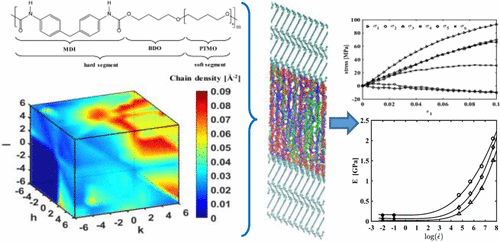当前位置:
X-MOL 学术
›
Macromolecules
›
论文详情
Our official English website, www.x-mol.net, welcomes your
feedback! (Note: you will need to create a separate account there.)
Atomistic Simulation of a Thermoplastic Polyurethane and Micromechanical Modeling
Macromolecules ( IF 5.1 ) Pub Date : 2017-09-05 00:00:00 , DOI: 10.1021/acs.macromol.7b01296 Nikolaos Lempesis 1 , Pieter J. in ‘t Veld 2 , Gregory C. Rutledge 1
Macromolecules ( IF 5.1 ) Pub Date : 2017-09-05 00:00:00 , DOI: 10.1021/acs.macromol.7b01296 Nikolaos Lempesis 1 , Pieter J. in ‘t Veld 2 , Gregory C. Rutledge 1
Affiliation

|
Thermoplastic polyurethanes constitute a versatile family of materials with a broad variety of engineering applications. However, connection between their chemical structure and mechanical properties remains elusive, in large part due to their heterogeneous nature, arising from segregation of chemically distinct segments into separate domains, with resulting complex morphologies. Using atomistic simulations, we examine the structure and mechanical properties of a common family of thermoplastic polyurethanes (TPU) comprising 4,4′-diphenylmethane diisocyanate and n-butanediol (hard segment) and poly(tetramethylene oxide) (soft segment). A lamellar stack model previously developed for the study of semicrystalline polymers is applied here for the first time to a phase-segregated copolymer. Equilibrium structure and properties were evaluated for TPUs with different ratios of hard and soft components, using a combination of Monte Carlo and molecular dynamics simulations. Stress–strain behaviors were then evaluated using nonequilibrium molecular dynamics (NEMD) simulations. The compositional dependence of the Young’s moduli thus obtained is shown to be well-approximated by a micromechanical homogenization model of the hard and soft components. Voigt (upper) and Reuss (lower) bounds of modulus were obtained for orientationally averaged aggregates and shown to be greater than those measured experimentally. The discrepancy is explained in terms of the strain rate dependence of elastic moduli, characterized by an Eyring-like function.
中文翻译:

热塑性聚氨酯的原子模拟和微机械建模
热塑性聚氨酯构成具有多种工程应用的通用材料系列。然而,它们的化学结构和机械性能之间的联系仍然难以捉摸,这在很大程度上是由于它们的异质性,这是由于化学上不同的链段被分离成单独的区域,从而形成了复杂的形态。使用原子模拟,我们检查了包含4,4'-二苯基甲烷二异氰酸酯和n-丁二醇(硬链段)和聚(四甲撑氧)(软链段)。先前为研究半结晶聚合物而开发的层状堆叠模型在此首次应用于相分离的共聚物。结合蒙特卡罗和分子动力学模拟,对具有不同硬,软组分比例的TPU的平衡结构和性能进行了评估。然后使用非平衡分子动力学(NEMD)模拟评估应力-应变行为。由此获得的杨氏模量的组成依赖性通过硬和软组分的微机械均质化模型被很好地近似。获得了定向平均聚集体的模量的Voigt(上部)和Reuss(下部)边界,并显示大于实验测得的边界。
更新日期:2017-09-05
中文翻译:

热塑性聚氨酯的原子模拟和微机械建模
热塑性聚氨酯构成具有多种工程应用的通用材料系列。然而,它们的化学结构和机械性能之间的联系仍然难以捉摸,这在很大程度上是由于它们的异质性,这是由于化学上不同的链段被分离成单独的区域,从而形成了复杂的形态。使用原子模拟,我们检查了包含4,4'-二苯基甲烷二异氰酸酯和n-丁二醇(硬链段)和聚(四甲撑氧)(软链段)。先前为研究半结晶聚合物而开发的层状堆叠模型在此首次应用于相分离的共聚物。结合蒙特卡罗和分子动力学模拟,对具有不同硬,软组分比例的TPU的平衡结构和性能进行了评估。然后使用非平衡分子动力学(NEMD)模拟评估应力-应变行为。由此获得的杨氏模量的组成依赖性通过硬和软组分的微机械均质化模型被很好地近似。获得了定向平均聚集体的模量的Voigt(上部)和Reuss(下部)边界,并显示大于实验测得的边界。









































 京公网安备 11010802027423号
京公网安备 11010802027423号